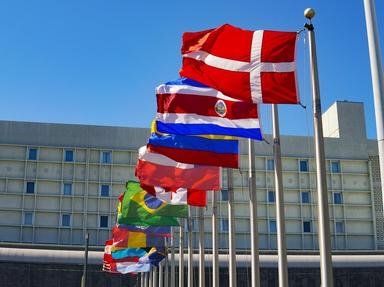Quiz Answer Key and Fun Facts
1. Let's have the simplest specimens to begin with - two striped flags. This former Soviet Union uses a horizontal bicolour with a strong azure stripe over a yellow one. The epicentre of a well documented twentieth century nuclear disaster, the nation could have drawn inspiration for the flag colours from fire and water, traditionally important symbols in the region. Kindly identify this country.
2. Here, have some duplicates. Three of them. These three national flags have some bondage - all of them are two striped flags in the colours red and white. One of these, however, is the odd one out, in that it has the white stripe on top and the red stripe below, rather than the other way round. Which of the given four *flags* is being spoken of?
3. Let's stick around with two striped national entities for a while. I'll describe the flag, you name the corresponding country. Here it goes: "a horizontal bicolour with a red stripe above and a white below, charged on the upper left on the red stripe by a white crescent moon facing a pentagon of five small white stars, the five stars themselves being five pointed."
4. Now let's add some stripes - one stripe. The given alternatives below show countries with flags having three stripes. All three stripes are of solid, single colours and there are *no additional symbols* on the flags. Under these constraints, just one pair is such that the corresponding flags have a white coloured stripe at the top. Identify this pair of countries from those given below.
5. Here's a slightly obscure piece. All the four national flags given below have two things in common - stripes and a single five pointed star. However, one of these carries a red star on itself; while in all others, the star is yellow. Your task - pick the *flag* that contains a *red* star as opposed to a *yellow* star.
6. One third of all world flags host religious symbols particular to that area's religions. Christian symbols, followed by Islamic symbols, feature most commonly on national flags. Two South American countries both depict the Sun of May, symbolic of the ancient Incan religion, on their flags. Both flags are adorned with alternating blue and white stripes. Which countries are these?
7. Liberia, Malaysia and the United States have strikingly similar flags. Multiple horizontal stripes in red and white, alternately, are accompanied by a blue field at the top left of the layout. In the sequence of Liberia, Malaysia and then the United States, tell me how many stripes in all appear on each of their flags, in this order.
8. Here's some unique stuff. From 1977 through to 2011, at the behest of national leader Muammar Gaddafi, his country's flag had just one lone stripe that spread out over the entire flag. In less technical terms, it was then the world's only single coloured flag. Which *flag* is the talk of the debate here? (PS - I'll have just the stripe, no extra designs needed. Thanks.)
9. These two flags have often kicked off political debates as they almost completely resemble each other, even in their colours, and differ simply by minor shade variations (and their side length ratios). Flag One is a horizontal triband in *bright vermilion, white and cobalt blue.* Flag Two is a horizontal triband in *red, white and light blue.* Given that both flags belong to European countries, give the countries corresponding to flags One and Two respectively.
10. Finally, here's a very unique flag to top things off. I'll describe the flag, you name it (the *flag*). Here it goes: "Five solid coloured bands radiating from the bottom of the hoist side. These appear in blue, yellow, red, white and green respectively, starting from the vertical hoist side and ending at the horizontal bottom side. All bands are oblique and not horizontal or vertical."
Source: Author
Trent500
This quiz was reviewed by FunTrivia editor
stedman before going online.
Any errors found in FunTrivia content are routinely corrected through our feedback system.

